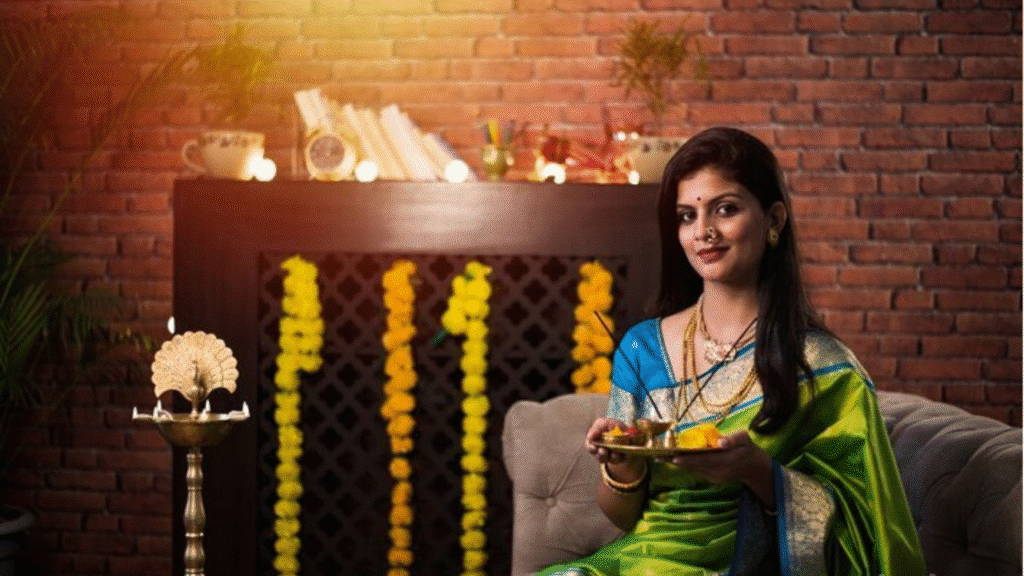As the monsoon paints the earth in shades of green, Hariyali Teej arrives like a celebration of nature, devotion, and femininity. One of the most striking visuals of this sacred festival is women dressed in vibrant green sarees, bangles, and jewelry, transforming the atmosphere into a canvas of cultural richness. But have you ever wondered why green is the chosen colour of Hariyali Teej?
The answer lies in a beautiful blend of mythology, seasonal transformation, spiritual symbolism, and age-old tradition.
Why Green Colour Is Worn on Hariyali Teej
The Hariyali Teej green colour isn’t just a stylistic choice—it is deeply rooted in symbolism. The word “Hariyali” itself translates to “greenery,” indicating a direct connection to nature and the monsoon season. This festival is observed during the month of Sawan (Shravan), when the rains rejuvenate the earth, and life flourishes in every corner of the landscape.
Check Out: Hariyali Teej 2025 Muhurat: Auspicious Timings & Powerful Rituals for a Joyous Celebration
Green symbolizes:
- Life and fertility
- Growth and harmony
- Peace and prosperity
- Auspicious beginnings
- Love, rejuvenation, and devotion
For married women, green represents the fertile strength of a relationship and the blessings they seek for their husband’s longevity, health, and happiness.
Spiritual Significance: Lord Shiva’s Connection to Green
In Hindu beliefs, green is considered a color dear to Lord Shiva, whose divine union with Goddess Parvati is the heart of the Teej celebration. It is believed that wearing green pleases both Shiva and Parvati, attracting their blessings for a harmonious and fulfilling marital life.
Goddess Parvati, after enduring years of intense penance, was finally united with Lord Shiva on this sacred day. Women emulate her devotion by fasting, dressing in green, and praying for a similar bond of love, faith, and understanding in their own lives.
Green Sarees, Bangles & Mehndi: A Complete Look of Devotion
The Hariyali Teej green attire includes not just sarees or suits, but a complete adornment of:
- Green bangles – Symbolizing health, happiness, and longevity.
- Green jewelry – Adding to the auspicious energy of the occasion.
- Mehndi (henna) – Considered a shubh (fortunate) sign, symbolizing love and deep connection.
- The “16 Shringar” – A full bridal adornment practiced by married women to honor their marital status and Goddess Parvati.
Wearing green during Hariyali Teej becomes a ritualistic expression of faith, beauty, and cultural pride.
A Festival of Devotion, Nature & Feminine Power
Hariyali Teej isn’t just a festival—it’s an experience. From singing traditional songs, swinging on decorated jhoolas, to receiving Sindhara (gift hampers) from maternal homes containing bangles, sweets, bindis, and clothes—the day is filled with joy and bonding.
Green in this context becomes more than a colour—it’s a spiritual uniform, one that links a woman with her faith, her feminine strength, and her natural surroundings.
Check Out: Hariyali Teej 2025 Look Ideas: Traditional & Bollywood-Inspired Outfits to Celebrate in Style
Hariyali Teej 2025: A Date to Celebrate
This year, Hariyali Teej falls on July 27, 2025 (Sunday). Women across North Indian states like Rajasthan, Uttar Pradesh, Madhya Pradesh, and Bihar are already preparing to immerse themselves in this green-hued celebration of love, devotion, and blessings.
The Hariyali Teej green colour is a powerful symbol—of life, tradition, and divine connection. It’s not just about looking beautiful, but about feeling spiritually empowered and emotionally grounded.
Whether you’re observing the fast, enjoying the festive songs, or simply embracing the beauty of Indian culture, wearing green on Hariyali Teej is a timeless tribute to nature, love, and the sacred bond of marriage.
